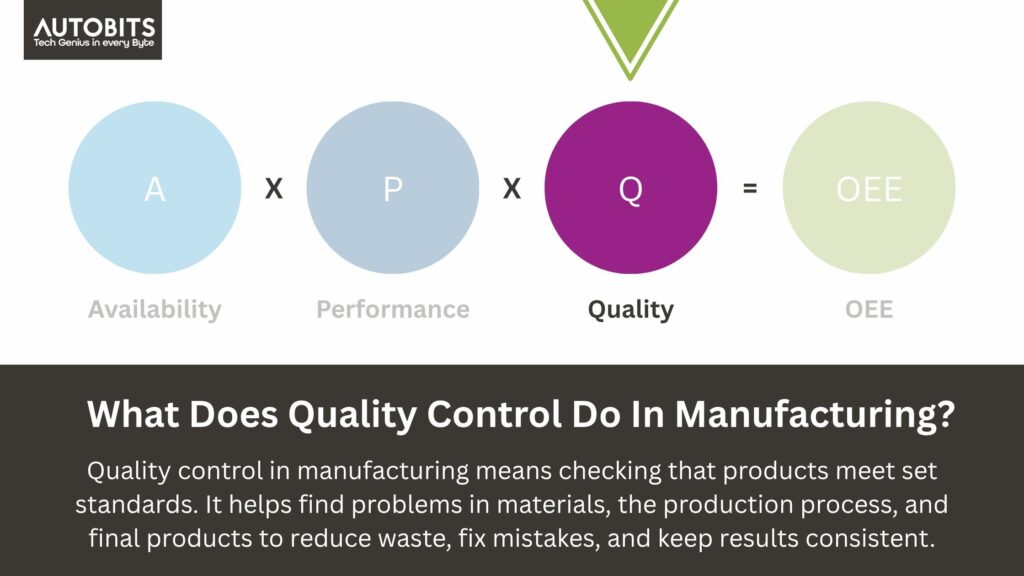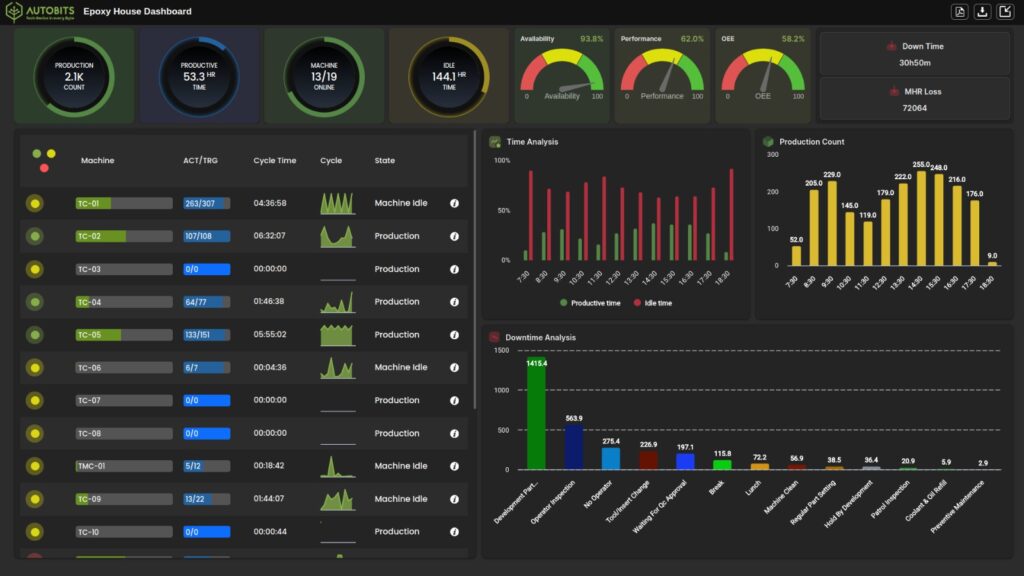As the manufacturing industry faces increasing competition and higher expectations for product consistency and customer satisfaction, it is extremely important to plan for quality control. Quality control has changed from inspections of finished goods to data-based quality systems. Given the ever-increasing market demands, ensuring quality in manufacturing operations has developed into more than just inspecting finished goods; instead, it requires continually using data to improve your quality program.
This blog will explore quality control, including the differences between quality control and quality assurance, key QC methodologies, and how manufacturers can leverage data to better control quality in their manufacturing operations.
What Does Quality Control Do In Manufacturing?

In manufacturing, quality control (QC) gives assurance that products or services conform to pre-established standards and specifications. Quality Control involves identifying defects in raw materials, the production process, and the delivered products in order to minimize waste, eliminate mistakes and deliver consistent results.
Quality control establishment and reliable functions in the manufacturing industry include:
- Inspections of raw materials for compliance
- Monitoring the progress of production to identify deviation
- Testing the finished product for defects
- Collecting and analysis of data and information to determine root causes of quality issues
In sum, quality control identifies faulty products. It prevents them from being delivered to the customer or end user and at the same time provides insight into improving an internal process. Quality control is key to quality manufacturing and is critical to maintaining a brand’s image with customers.
Quality Control vs. Quality Assurance
Many confuse quality control with quality assurance (QA). Though they both aim to ensure product quality, their focus and methods differ.
| Aspect | Quality Control (QC) | Quality Assurance (QA) |
| Focus | Product | Process |
| Objective | Identify defects | Prevent defects |
| Timing | After production | Before and during production |
| Methods | Inspection, testing | Audits, documentation, training |
In short, QC is reactive, detecting issues after they occur, whereas QA is proactive, aiming to prevent issues from happening in the first place. Both are necessary for comprehensive factory quality control.
The Importance of Quality Control in Manufacturing

Bad quality could result in product recalls, extra costs, damaged reputation, and unhappy customers. An effective QC process provides:
- Improved Product Quality: Quality control processes identify defects and irregularities sooner in the process. Identifying issues sooner ensures that products that meet standards and specifications are delivered to customers, providing better reliability and performance.
- Improved Safety: Quality control is critical for reducing the chances of product failures and accidents in industries such as automotive, aerospace, and pharmaceuticals for enhanced consumer safety.
- Cost Effectiveness: Quality control reduces costly rework, scrap, and product recalls. Identifying defects early optimizes resource output and improves overall production costs.
- Compliance: Quality control verifies compliance with industry performance standards and regulatory requirements, limiting corporate legal liability and risk.
- Brand Loyalty: Consistent, high-quality products can help build a positive brand reputation, creating customer loyalty and allowing differentiation in a market with similar offerings.
- Customer Satisfaction: Meeting and/or exceeding customer expectations will result in customer satisfaction, potential repeat business, and positive word of mouth, which is vital for your brand’s success.
- Improved Processes: Effective quality assurance is a reflection of problem-free operations in the manufacturing process, as it is used to find inefficiencies and where improvements can be made, which leads to more efficient processes.
- Reduced Waste: Quality control means less defective or rework output, allowing for more sustainable processes and less environmental impact.
- Employee Morale: When employees have a role in a top quality company, it really boosts pride in the workplace and morale among employees. It is how company culture supports continuous improvement.
Quality control does not have to be seen as simply a technical requirement of the manufacturing world; it is a condition of success. Quality control relies on operationally well-functioning processes (efficiency) and combines that with consumer trust and long-term profitability. Quality control is essential for any manufacturer who wishes to compete at any level and is ultimately concerned about a sustainable operation.
Quality Control Methods and Techniques
Quality control processes utilize various methods and tools to establish consistency and conformity. Some of the most common techniques and tools include the following:
- Statistical Process Control (SPC): Involves using data and statistical tools to monitor production processes to recognize patterns, trends, and anomalies.
- Six Sigma: A data-driven process to continually improve the quality of the output process by eliminating causes of defects. It seeks to simplify process improvement activities using a DMAIC (Define, Measure, Analyze, Improve, and Control) approach.
- Total Quality Management (TQM): Involves a company-wide effort to manage quality by stressing continuous improvement and customer satisfaction. Every employee participates in the QC process.
- Inspection and Testing: Used to determine whether a product meets specifications utilizing visual inspections, mechanical tests, and chemical characterizations.
- Checklists and Audits: A tool to standardize inspections and ensure each step of the production quality control process is followed correctly.
Comparison Table: Key Quality Control Techniques
| Technique | Main Focus | Key Tools/Methods Used | Strengths | Typical Applications |
| Statistical Process Control (SPC) | Monitoring process stability and variation | Control charts, real-time data analysis | Early detection of trends and anomalies; reduces waste; improves productivity | Continuous manufacturing, process industries |
| Six Sigma | Reducing defects and process variability | DMAIC framework, statistical analysis | Data-driven; systematic defect reduction; process optimization | Manufacturing, services, large-scale operations |
| Total Quality Management (TQM) | Company-wide continuous improvement | Employee involvement, process integration | Enhances culture of quality; customer-centric; long-term improvement | Organization-wide, cross-functional teams |
| Inspection and Testing | Verifying product compliance with specifications | Visual checks, mechanical/chemical tests | Direct defect detection; ensures product meets standards | All industries, especially critical products |
| Checklists and Audits | Standardizing and verifying QC procedures | Checklists, audit forms, documentation | Ensures consistency; easy to implement; improves accountability | Routine inspections, compliance verification |
These techniques help build a systematic and consistent quality manufacturing framework.
How Can Quality Control be Improved in Manufacturing?
Previously, quality control was dependent on inspections and paper logs. Now, QC can use data and technology to provide real-time visibility and reduce quality defects while consistently improving quality. Here is how:
Real Data Monitoring
You can install sensors, IoT devices, or other monitoring systems on your machines to collect real-time data regarding temperature, pressure, speed, etc. This allows manufacturers to detect if there is a deviation in the process as it happens.
Analytics and AI
You can analyze your collected data to find unique cases of failures or find spots that have failure potential. Use of AI can help adjust production settings to be able to provide consistency to what you are producing.
Digital Dashboards
Your metrics on the quality control process for the factory can be more visual than numeric this way. You can track defect rates, process times, inspections, etc., all in direct comparison, which allows you to narrow down what method you used in the factory that gave you a good result vs. less than a good result.
Integrated ERP Systems
Enterprise Resource Planning (ERP) systems can combine your quality control plans with other functions in the business, such as inventory management, supply chain management, and production planning, giving a complete value chain picture.
Employee Development in Data
You utilize the data to create training opportunities with your employees and use data to evaluate the work overall. This gives employees access and allows them to recognize human errors, lessening backend error spots in the QC process.
Root Cause Analysis
When there is a defect, the first post-action should be to analyze the data to trace the defect back to its source. Once you have established the source of the defect, correct the root cause instead of simply fixing an outward issue.
By turning quality control into a data-driven process, manufacturers can shift from reactive to proactive, thereby ensuring higher levels of product quality control and customer satisfaction.
Using Real-Time Data for Quality Control: A Smarter Approach to Manufacturing

In today’s data-driven manufacturing world, quality control begins with visibility, and it all starts on your production floor. At Autobits Labs, we help manufacturing operations improve production with machine monitoring software.
Our software provides real-time machine data, so you have the information to make intelligent decisions, minimize unknown downtime, and continuously improve your quality program. You have complete visibility into your production processes with one easy-to-use dashboard.
Our machine monitoring software is designed to work with your favorite CNC machine manufacturer, including DMG MORI, HAAS, Mazak, SYIL, Hurco, and Fadal. You can improve productivity and increase quality—without guesswork.
Join Us to See the Difference Yourself
Schedule a free demo to see for yourself how real-time data can help you make measurable improvements in quality and performance. [Schedule Your Free Demo Today]
Conclusion
What is quality control in manufacturing? It’s not simply identifying defective products—it’s a strategic, data-driven process to manage consistent excellence. Manufacturers can turn quality control into a competitive advantage with technology and current data.
We can use data-driven quality control to advance beyond basic inspection and into predictive analytics. In other words, the further we can move our operations into the realm of data, the better our production quality control will be. The more information you make available, the better you can evaluate it, make informed decisions, and provide superior quality products and services.
If you’re still using manual or outdated practices, it’s time to rethink your quality program and allow data to be your best asset in quality manufacturing.
FAQs
What does quality control mean in manufacturing?
Quality control is a manufacturing company’s process to ensure its products meet specific standards and specifications by eliminating defects found in raw materials, production, and finished goods.
What is the difference between quality control and quality assurance?
Quality control is focused on identifying defects in products after they have been created; quality assurance is focused on improving quality control processes to eliminate the possibility of defects occurring in the first instance.
What data-driven value does quality control provide to manufacturers?
Having information allows manufacturers to identify issues as they occur, conduct root cause analysis, and make data-driven quality decisions that can enhance consistency, lower costs, and improve product quality.
What are some standard quality control techniques that fit within a manufacturing environment?
Common techniques include Statistical Process Control (SPC), Six Sigma, Total Quality Management (TQM), visual inspection methods, and templates for checklists.
What is the best way for small manufacturers to utilize data for quality control?
Small manufacturers can start by adding inexpensive digital tools to their quality control process, such as affordable quality management software, real-time monitoring sensors, or Excel-based data log sheets that track defects and demonstrate the ability to measure trends and quality improvement processes.





